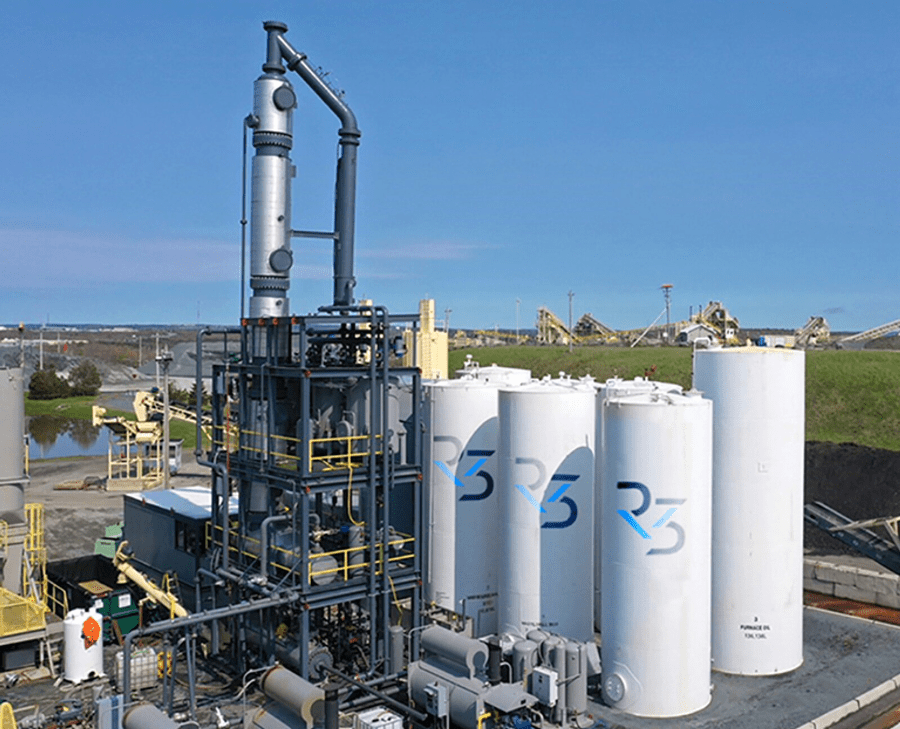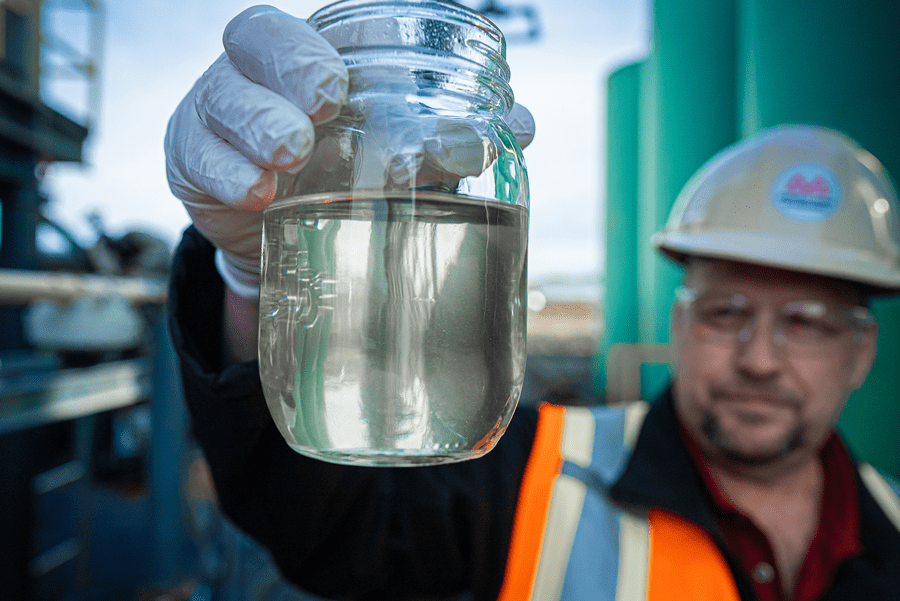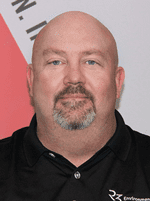For R3’s solution to recovering synthetic drilling fluid, this meant a combination of expertise, innovation, patience and persistence.
Our “aha” moment came at 2 a.m., after another long day and night of researching in a lab in Tennessee. Two Canadians, along with members of the Astec Industries, worked to complete repeated variations on a system to perfect that processing of drill muds, yet again. This time it would be different, however, as a crystal-clear fluid began to appear.
At first glance, the fluid appeared to be water but, upon further investigation, it had an “oil feel” to it. We grabbed a nearby empty can of cola, flipped it upside down, poured the fluid on the bottom and lit it. Pure oil!
After many more months of research, testing and development, our investment ultimately led to the solution that we believe can significantly reduce the waste produced in the oil and gas industry.
Today, we are proud to offer services using our proprietary Vacuum Assisted Pure Oil Recovery Technology.
R3 Environmental Systems
At R3 Environmental Systems, we are first and foremost scientists. Whether it’s removing hydrocarbons from contaminated soil or treating traditional waste oils, we are driven by finding the right solution – even if it doesn’t yet exist. Such was the case with our approach to applying vacuum distillation to drilling mud in the oil and gas sector.
We already understood the environmentally sensitive nature of oil and gas exploration, and that high-performance drilling fluids are not only expensive, but also wasteful. In fact, over $7 billion was spent on drilling fluid in 2019, with all but six percent coming back as waste or “cuttings.”
We also knew that environmental regulations require proper treatment of these cuttings to reduce residual hydrocarbons to acceptable levels before safe disposal and, essentially, that was the most widely used process at the time: treatment and disposal.
At R3, we felt there had to be a better way. What if drill mud cuttings could be treated and then reused? Was there a more efficient and responsible (both environmentally and financially) way to recover the drilling mud waste for subsequent use in future drilling events? Could the recovered oil be brought back into the exploration cycle?
Thanks to the backing of our parent organization, the Municipal Group of Companies, our team was able to work with our friends at Astec to pursue this innovative approach.

The Process
The first stage of our recovery process requires heating the material under a low vacuum to evaporate the oil and water fractions, which are subsequently collected, condensed and separated into hydrocarbon and water products. The use of a low vacuum within the distillation unit (VDU) significantly lowers the temperatures required to evaporate the hydrocarbons associated with the drilling fluid. This reduction in boiling point temperatures reduces energy consumption and guarantees that the operational temperature never reaches levels that would result in thermal cracking or degradation of the drilling fluid. Because of this, the recovered fluid maintains its integrity.
As a result, the high-quality drilling fluid* recovered when using the technology means the recovered fluid can be used as a direct substitute for virgin drilling fluid in the formulation of new drilling mud products. Recovering and reusing the base drilling fluid instead of using new drilling fluid is an opportunity for the industry to reduce greenhouse gas emissions while maintaining quality standards. Oil and gas companies can thereby significantly reduce the amount of virgin drilling fluid they need to purchase, transport and eventually dispose of.
Once the drilling fluid has been recovered, the residual solids will still contain the high molecular weight hydrocarbons that came from the reservoir oil. Traditionally, these residual solids or sludges have been sent for landfill disposal or to a low temperature thermal desorption unit where the hydrocarbons are destroyed. Neither of these traditional options allowed for the utilization of the hydrocarbons within the solids.
In R3’s recovery process, the residual hydrocarbons and solids can be processed to generate an alternative fuel that can be utilized as an industrial fuel source, in this case fuel pellets. This is achieved by fusing together the residual hydrocarbons and several proprietary binders into a solid mass, which is then extruded in predetermined sizes and shapes. Each fuel pellet is tailor-made to fit the needs of the end user by adjusting the heating value, moisture content, ash content and pellet dimensions. The energy content of the produced pellets is very similar to that of a traditional wood pellet.
Another distinctive feature of R3’s recovery technology is its portability. The entire unit was designed as a series of “modules” that can be transported by traditional methods to remote exploration sites anywhere in the world. Using our new technology at remote sites can greatly reduce the quantity of virgin drilling fluid required and the production of waste that will need to be removed from the site at the end of the exploration program. Once the project comes to an end, the recovered drilling fluid can be removed from the site and reused during another exploration project. Additionally, the recovered water can be reused onsite, with the fuel pellets used in onsite boilers and heaters.
The Takeaway
Realizing the overall benefit of our process, that Vacuum Assisted Pure Oil Recovery can help reduce the carbon footprint and other environmental impacts of oil and gas exploration and production, the next step was to share our “aha!” moment with the industry. As such, we are honored to have received the 2022 Spotlight on New Technology Award at the recent Offshore Technology Conference. This recognition not only acknowledges the hard work and dedication of our innovative team, but also helps promote our primary motivation: To embrace the challenges of utilizing new technology to make a difference in creating a greener future.
*The quality of the recovered drilling fluid has been independently evaluated by a third-party engineering firm and the Chemical Abstract Service, a division of the American Chemical Society, both of which found the fluid to be equivalent to the virgin drilling fluid. As a result of this evaluation, the recovered drilling fluid, which we market as SecondSource drilling fluid, has been assigned the same CAS number as the original base drilling fluid.
Headline photo: R3’s high-quality recovered drilling fluid (“SecondSource”) can be used as a direct substitute for virgin drilling fluid. Photos courtesy of R3 Environmental Systems.
Patrick Rooney, an experienced project manager and leader in manufacturing, has had the chance to be a part of the success story of Municipal Group of Companies for over two decades. Alongside Jerry Scott, one of the two inventors of the R3 Environmental Systems’ Vacuum Assisted Pure Oil Recovery technology, he thrives when cracking the most difficult of problems and making the world better for it. Rooney is the director of manufacturing at the Municipal Group of Companies, a recognized leader in heavy civil construction, waste management, logistics and mining support services, within Eastern Canada, the Caribbean, the U.S. and beyond.
Oil and gas operations are commonly found in remote locations far from company headquarters. Now, it's possible to monitor pump operations, collate and analyze seismic data, and track employees around the world from almost anywhere. Whether employees are in the office or in the field, the internet and related applications enable a greater multidirectional flow of information – and control – than ever before.




